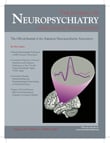Paroxetine-Induced Bruxism Effectively Treated With Tandospirone
SIR: Several case reports have shown that selective serotonin reuptake inhibitors (SSRIs) induced bruxism. 1 This letter reports a patient with paroxetine-induced bruxism who was effectively treated with tandospirone, a partial agonist of the 5-hydoxytryptamine (5-HT) 1A receptor. Tandospirone is less potent at dopamine D 2 receptor than buspirone. 2
Case Report
“Mr. Y,” an 81-year-old depressed Japanese man, received a 4-month trial of sulpiride, a common antidepressant medication used in primary care clinics in Japan. Since his depressive symptoms did not improve, he was referred to the psychiatry clinic. At that time, he experienced all nine criteria for major depressive disorder outlined in DSM-IV. 3 He agreed to a trial which replaced sulpiride with paroxetine.
A regimen of paroxetine was started with a bedtime dose of 10mg. After 7 days at this dosage with no reported adverse effects, the dosage was increased to 20mg/day. At the 14-day follow-up, depressive symptoms remained, although his mood had improved. The dosage was again increased to 30mg/day. At the 21-day follow-up, his depressive symptoms were under better control. He was very pleased with this treatment. However, he complained of “night-and-day jaw clenching” and “sore jaws and teeth.” His wife also witnessed his symptoms. Within a week of adding tandospirone, 10mg p.o. t.i.d., to the regimen, he reported that his jaws no longer clenched and that sore jaws and teeth improved.
Comment
This case report shows that the patient developed bruxism after starting on a regimen of paroxetine. It has been postulated that disturbances in the central dopaminergic system, especially within the mesocortical tract, are linked to bruxism. 4 SSRI-induced bruxism is considered to be a consequence of serotonergically mediated inhibition of the dopaminergic system. In addition, in this case, elderly age and prior neuroleptic exposure (sulpiride: D 2 and D 3 antagonist) before starting paroxetine predisposed him to develop bruxism.
It has been reported that buspirone, a partial agonist of the 5-HT 1A receptor, ameliorates SSRI-induced bruxism. 1 , 4 This case suggests that tandospirone also improves paroxetine-induced bruxism. Several mechanisms can be considered in explaining why 5-HT 1A agonists relieve SSRI-induced bruxism. It has been shown that systematic administration of 5-HT 1A receptor agonists increases dopamine release in the prefrontal cortex. 5 This effect is considered a major factor in ameliorating bruxism.
The precise mechanism of how 5-HT 1A receptors regulate dopamine release is not known; however, several mechanisms have been postulated. Presynaptically, agonist activation of the somatodendritic 5-HT 1A autoreceptors in the raphe, which reduces 5-HT cell firing, synthesis, and release of 5-HT, is considered to increase dopaminergic neuron firing in the ventral tegmental area and synaptic release of dopamine in the prefrontal cortex. 4 Postsynaptic effects are also suggested since 5-HT 1A receptors are localized on nonserotonergic neurons in various brain regions, including the prefrontal cortex. It has been shown that dopamine release is modulated by postsynaptic 5-HT 1A receptors in the prefrontal cortex. 6
This case adds to the literature by suggesting that SSRI-induced bruxism can be treated with tandospirone, a 5-HT 1A receptor agonist.
1. Winocur E, Gavish A, Voikovitch M, et al: Drugs and bruxism: a critical review. J Orofac Pain 2003; 17:99–111Google Scholar
2. Hamik A, Oksenberg D, Fischette C, et al: Analysis of tandospirone (SM-3997) interactions with neurotransmitter receptor binding sites. Biol Psychiatry 1990; 28:99–109Google Scholar
3. APA: Diagnostic and Statistical Manual of Mental Disorders, 4 th ed. Washington, DC, American Psychiatric Publishing, 1994, pp 339–344 Google Scholar
4. Bostwick JM, Jaffee MS: Buspirone as an antidote to SSRI-induced bruxism in 4 cases. J Clin Psychiatry 1999; 60:857–860Google Scholar
5. Tanda G, Carboni E, Frau R, et al: Increase of extracellular dopamine in the prefrontal cortex: a trait of drugs with antidepressant potential? Psychopharmacology (Berl) 1994; 115:285–288Google Scholar
6. Sakaue M, Somboonthum P, Nishihara B, et al: Postsynaptic 5-hydroxytryptamine(1A) receptor activation increases in vivo dopamine release in rat prefrontal cortex. Br J Pharmacol 2000; 129:1028–1034Google Scholar



